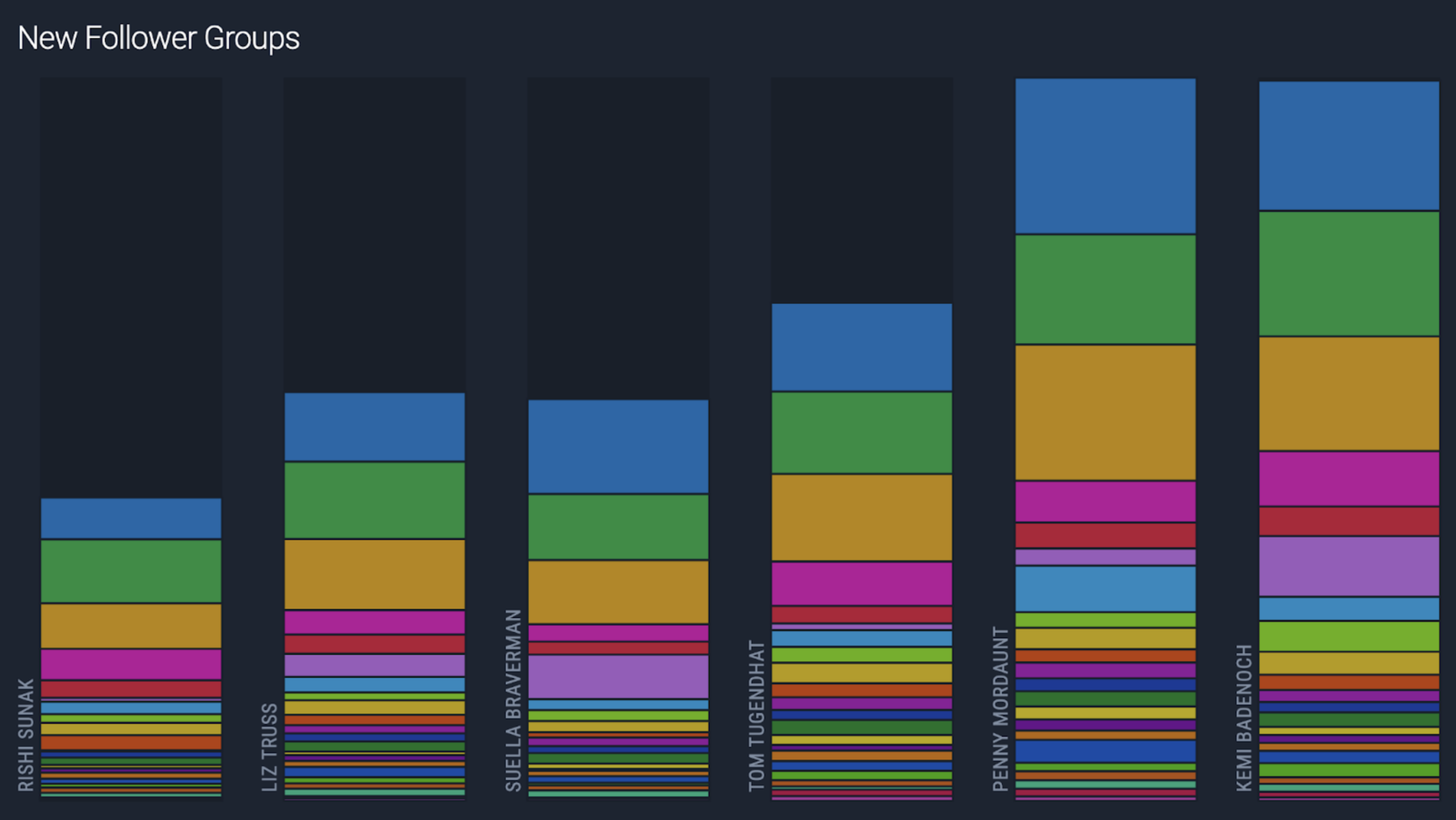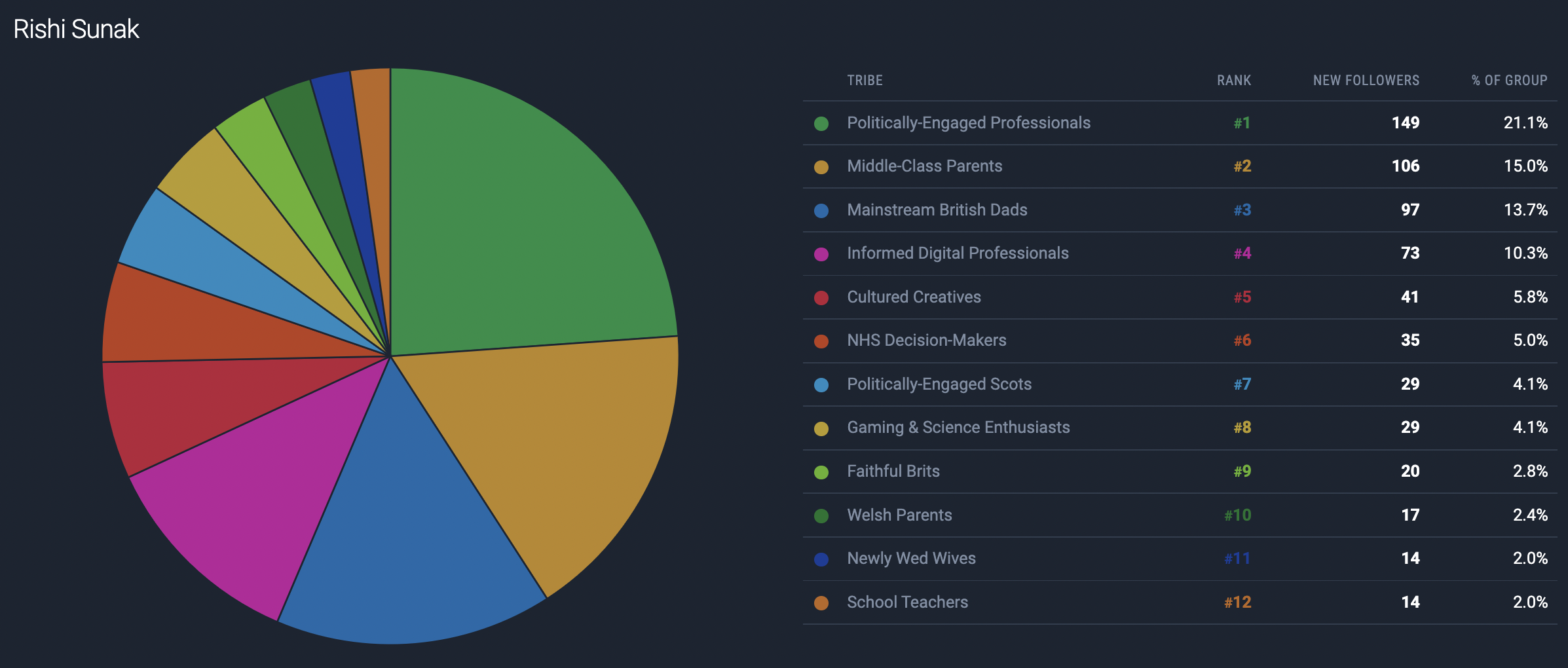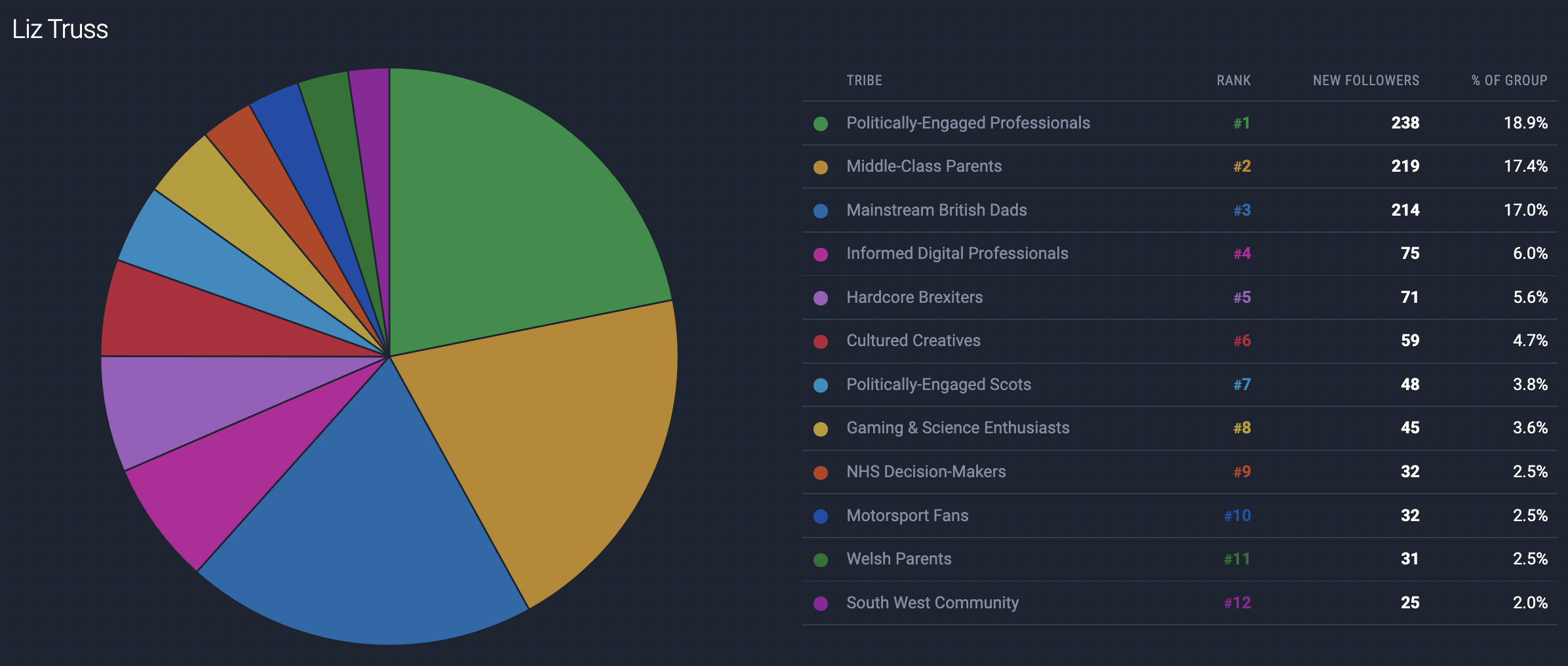Since Boris Johnson’s long-expected resignation, candidates in the Conservative party have been battling out with their fellow party members for their opportunity to become the 78th Prime Minister of the UK.
We set out to understand the impact that the Tory leadership race has had on each of the different candidates’ audience perception. Using the Fifty Platform, we uncovered the new followers of all candidates over the last few weeks to determine who has gained the most social media exposure from the process and who their recently-acquired supporters are.
Methodology
We ran an analysis into all of the new followers of the prospective candidates to understand which audiences and issues resonated most with each candidate. Here’s what we found.

Who made the biggest gains and from where?
Interestingly, the bulk of Sunak's new following was based internationally. With a large portion of this audience hailing from India, it appears that his and his wife’s Indian heritage may have played a role in his increased popularity abroad.
Unlike some of the other candidates, Sunak had a substantially larger following prior to the contest than his counterparts. Despite being a relatively young candidate, Sunak has seen a meteoric rise to the cabinet and following his appointment to Chancellor just before the pandemic, he arguably became the UK’s most popular politician by the end of 2020.
By contrast, Liz Truss’s followers were primarily UK-based and yet, after Sunak, Truss gained the second smallest number of total British followers, likely due to the international exposure she gained in her role as Foreign Secretary. Truss is currently the tenth most popular Conservative politician in the UK, whereas Sunak remains ahead in third place.
Although less successful in their bid to become party leader, the other candidates were those who stood to gain the most followers throughout the contest. Kemi Badenoch and Penny Mordaunt acquired the most British followers, with Tom Tugendhat and Suella Braverman also garnering considerable UK support.

What did their new followers look like?
Throughout the study, we saw a wide range of tribes and interests emerge that fell outside the traditional political sphere. This is perhaps due to their newer followers being less ‘hardcore’ Conservative party members and instead hailing from the wider Informed Professionals landscape, which would explain why their interests do not align with those typically associated with conservatism.
We can see the broader, more mainstream segments of society emerge in the tribes of Mainstream British Dads and Middle-Class Parents, which both indexed as some of the largest in the study. What was interesting to see in these tribes was that the lesser-known candidates made much more significant gains. In the top tribe of Mainstream British Dads, for example, Suella Braverman had a 10% greater audience gain compared to Rishi Sunak.
Other key audiences that indexed highly in the study ranged from the highly informed Politically-Engaged Professionals and Tech-Savvy Professionals, through to more vocational tribes, such as NHS Decision-Makers and British Farmers.
With key issues of Levelling up and the current state of the union in question over the last few weeks, it’s not surprising to find key tribes of Politically-Engaged Scots as well as local audiences in Manchester, Birmingham and the South West. Penny Mordaunt resonated the most with Scottish audiences, acquiring the largest percentage increase of Scottish followers.
How did their new audiences align with how the candidates were hoping to be perceived?
With the race now down to the final two, Rishi Sunak and Lizz Truss, refining their policies and attaining the support of their party voters have become the priority. We analysed the results of both candidates to understand if their new audiences were in line with the supporters they had set out to attract.
Sunak’s rhetoric throughout the contest has centred around the economy and how to manage it effectively to prevent a recession. His views and policies on issues surrounding Brexit and immigration, however, have been less notable. Our analysis confirmed that senior professionals, those with a larger organic interest in the economy, made up Sunak’s largest audiences. These professionals also held the largest gain by the percentage of professionals in his own audience.
Another other strong area for audience growth was NHS Decision-Makers. Following on from his bold promise to place the NHS on a "war footing" and tackle waiting lists, it is not surprising that Sunak had double the amount of new followers in this audience compared to any other candidate.
Despite being known as an ardent Brexiteer, Hardcore Brexiteers only made up 1.3% of Sunak’s new followers, compared to Suella Braverman’s 11.1%, suggesting that the recent reveal of Sunak’s US Green card and questions over tax evasion may not reflect the ‘pro-Britain’ stance of this particular audience.
Liz Truss’s audience had clear distinctions from her parliamentary colleague, with higher makeup of more mainstream and broader audiences and fewer Politically-Engaged & Informed Digital Professionals. In fact, 24.9% of her audience consisted of senior professionals compared to Sunak’s 31.4%.
The key area of Truss’s gain over Sunak besides her uptick in broader, more traditional mainstream tribes, was in the Hardcore Brexiteers audience, which made up 5.6% of her total audience. Despite voting remain in the 2016 referendum, Truss has since backtracked and become especially vocal regarding issues such as immigration and Brexit, playing to the eurosceptic wings of Conservative voters.


Conclusion
Although the race is still underway, it would seem that both Truss and Sunak’s campaign efforts are paying off. Our analysis shows that the two candidates have amassed an impressive new following over the last few weeks, with both seeing a marked increase in support from middle-class, politically-engaged and professional audiences. As for who will make it to Number 10, it’s up to the Conservative MPs to decide, but the successful candidate will no doubt need to tap into their respective supporters and using those learnings to appeal to party members. After all, perhaps more than anyone, politicians should understand the importance of knowing their audience.
To learn more about how Fifty can use data to identify, target and reach new audiences over time, get in touch with our sales team at [email protected] or book a demo directly with our team.






































